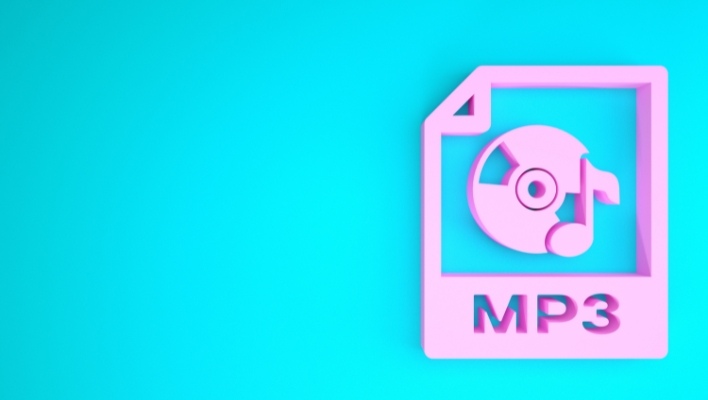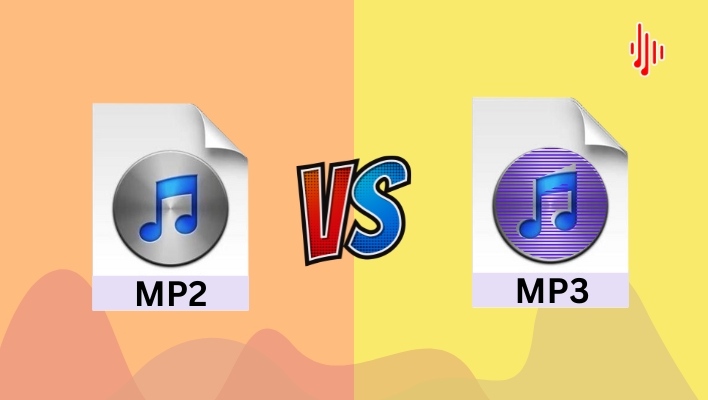Music files and audio files in general, are available in all types and sizes. When organizing and storing your digital music file collection, you may come across several file formats, from large and complex FLAC and ALAC files to standard files such as the MP3 or AAC. Each of these audio files or codecs transmits music (encoded in data) to our ears in a different way.
The best file format varies depending on your music needs or the tradeoffs you are willing to make in terms of audio quality and storage space. Today, we’ll break down MP3 vs MP2, the two being among the oldest and the most common music file formats. The guide will help you understand their similarities and differences before you can choose the best format for your next music project.
We have also featured MP3 in the following articles;
Here is a quick comparison of MP2 files vs MP3
| MP2 | MP3 | |
| File size | Relatively larger file size | Smaller file size |
| Compatibility | Limited compatibility | Near-universal compatibility |
| Compression level | Low bit rate | Higher bitrate |
| Audio quality | Potentially better audio quality | Audio quality might suffer |
| Compression method | Lossy format | Lossy format |
| Usage | Limited usage | Widely used |
Both MP2 and MP3 files come in different forms, and each contains different audio data. This means they differ in terms of audio quality experienced by end users. Let’s take a closer look at each of these digital file formats.
What is MP2?
MP2, which stands for MPEG-1 Audio Layer II, is a type of lossy audio compression audio used for sharing and storing digital audio data. Initially, MP2 was used as the standard file format for audio broadcasting, but it is now used in multiple digital file applications. This format was developed as the predecessor of MP3, but the latter remains the dominant file for storing and sharing audio data on the internet and PC applications.
Like other lossy file formats, MP2 utilizes a perceptual coding method to strip off information that the human ear cannot perceive easily. It does this by ignoring the frequencies that are considered to be indiscernible, thereby allowing the reproduction of relevant frequencies only.
MP2 uses 32, 44.1, and 48 kHz sampling rates and bit rates from 32- 320 kbps to achieve different audio quality. MP2 files are compatible with a variety of media players, including Windows players, QuickTime, VLC, etc. The files are quite similar to MP3 ones, but MP2 has a lower bit rate, plus is not as widely used. Like other file formats, MP2 can be converted to other formats using appropriate audio conversion software.
If you’re using a file with the ‘.mp2’ file extension, then it means that audio data is available in the MP2 format. You can play the file on a compatible media player or simply convert it to MP3 or any other audio format if needed.
MP2 is widely used in broadcast applications to store digital audio in payout systems. It is also used to distribute live audio over different networks, including ISDN, satellite, and IP Networks. Some DVD video players use stereo MP2 decoders, making it a close competitor for Dolby Digital. In addition, some DVD recorders store data this format, although it is rare to find commercial DVDs using MP2 soundtracks.
MP2 is also used as the standard digital file format for Video CD (VCD) and Super Video CD (SVCD) applications. That’s not all. MP2 is also one of the widely used formats in HDV camcorders. In addition, MP2 is compatible with a range of portable audio players, which allows the user to enjoy music on the go.
Advantages of MP2
- Better sound quality
- Retains most of the recording data
- Improved error resilience
Disadvantages of MP2
- Large file size
- Limited compatibility- it is not supported across the board

MP3 files
MPEG-1 Audio Layer III, or simply MP3 is a popular lossy digital audio encoding format used to store audio files. Like its MP2 counterpart, MP3 uses a lossy compression method to help reduce the size of your audio files.
Generally, MP3 is one of the most used formats for sharing and storing music and other files. This is because, the format offers a relatively high level of file quality while allowing you to keep the file size small.
As we have mentioned, MP3 files are generated using lossy compression, meaning some of the audio data is lost. The method removes any of the audio data that is regarded to be less significant or less noticeable by the human ear. This results in a significant reduction in the final MP3 file size.
The reduction in file size is perhaps the biggest advantage that MP3 has over other file formats. A typical MP3 file is about 1/10 of the original file size. However, some bass notes as well as high frequencies may degrade audio quality during the ripping (compression) process.
That said, you’ll need to take caution when encoding files in MP3 format to avoid deteriorating the audio quality. The good is that most high-end media players and devices can easily detect poorly mixed MP3 audio files.
The compressed file is stored using the ‘.mp3’ file extension, which can easily be played on a variety of compatible media players and devices. Generally, MP3 is universally compatible with a wide range of devices/ editing software, and is one of the most preferred formats for storing and sharing digital files online.
Advantages of MP3
- Supported by common media players- works seamlessly with most devices
- Easy to share MP3 files over the internet
- Smaller file size- require less storage space
Disadvantages of MP3
- The audio quality may suffer during compression depending on what is stripped off

MP2 vs MP3 – Which File Format is Better?
Choosing the best format between MP2 and MP3 will vary depending on what you intend to do with the audio. Both MP2 and MP3 files use a lossy compression method, meaning they result in reduced file size but at the expense of some loss of audio quality.
Generally, the person creating either an MP2 or MP3 file chooses a bit rate, which determines how many kilobits per second (kbps) of data are needed. The bit rate used is also critical in determining the size of the resulting file.
MP3 is generally more popular, and you can find it on nearly all devices and media players in the market. It is the most ideal format if you want your music files to be easy to access or easy to download and share online. In addition, MP3 is supported by most editing programs, which come in handy when using specialized editing equipment.
One of the primary differences between MP2 and MP3 is that the latter offers a higher level of compression, meaning it is more advanced than its MP2 counterpart. This also implies that MP2 files are much larger, but tend to offer better audio quality since they retain more of the original audio data.
Remember, large files can be complicated to convert, handle and share, but they offer better-quality audio. If you prioritize audio quality over anything else, the MP2 will help you achieve the audio quality you desire. So, if you’re a discerning audiophile looking to enjoy the best audio quality, MP2 will allow you to enjoy high-fidelity music, but you’ll require more storage space.
On the other hand, if you are looking to share music files quickly over the internet, MP3 format is your best option. It is also ideal if you’re looking to save disk space, but it is likely to result in a slight loss in audio quality. However, the loss in audio quality is negligible, and it is often almost impossible to tell the difference.
In terms of compatibility and supported devices, MP3 is the overall winner as it is compatible with multiple devices and a wide range of software applications. On the other hand, MP2 offers limited compatibility and might not support some software applications, but it is still widely accepted.
When it comes to the scope of application, MP3 is the most preferred format for computer applications, as well as internet and audio players. On the other hand, MP2 is widely used in digital radio applications and television broadcasts.
Final Thought
Whether you are learning to mix and master audio or just listening to music, ensure to go with a digital file that fits your needs best. Generally, both MP2 and MP3 remain unaffected despite the sprouting of new audio file formats. And despite having obvious disadvantages, the two music files will continue to dominate the digital music scene for the next few decades.
